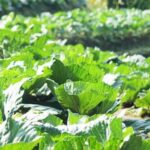Are railroad ties safe for vegetable gardens? Before incorporating them into your garden, it’s crucial to weigh the potential risks.
Railroad ties have been a popular choice for building raised beds and retaining walls in vegetable gardens, but concerns about their safety have sparked debate among gardeners and experts. In this article, we will explore the use of railroad ties in vegetable gardening, their composition, potential health risks, environmental impact, alternative options, regulations and guidelines, and real-life case studies.
Railroad ties are wooden beams that were historically used to support rail tracks. While they are sturdy and durable, they are often treated with creosote, a toxic chemical used as a preservative. Creosote contains compounds that can be harmful to human health and the environment. This has raised questions about whether using railroad ties in vegetable gardens is a safe choice.
The potential health hazards associated with creosote-treated railroad ties include exposure to toxic chemicals that can leach into the soil and come into contact with vegetables. Additionally, there are environmental concerns related to the leaching of these chemicals into the soil and water supply. As more people become aware of these risks, many are seeking alternative options for building raised beds or retaining walls in their vegetable gardens.
What Are Railroad Ties
Railroad ties, also known as crossties or sleepers, are the rectangular support beams used in the construction of railway tracks. Typically made from wood, such as oak or pine, railroad ties have been historically treated with creosote, a toxic chemical used to preserve and protect the wood from decay and pests. This treatment has allowed railroad ties to withstand the harsh outdoor conditions for extended periods of time, making them attractive for use in landscaping and gardening projects.
The composition of railroad ties can vary depending on their age and origin. Older railroad ties are more likely to contain creosote, whereas newer ones may be treated with alternative preservatives or chemicals. Despite their durable nature and affordable cost, concerns have arisen about the safety of using railroad ties in vegetable gardens due to potential exposure to toxic substances like creosote.
Historically, railroad ties have been repurposed for use in landscaping and gardening due to their affordability and sturdiness. Common uses include building raised beds, retaining walls, or pathways within vegetable gardens. While their durability makes them appealing for these purposes, there is growing awareness of the potential risks associated with using railroad ties in close proximity to edible plants.
Potential Health Risks
Railroad ties, also known as crossties or sleepers, are wooden or concrete beams traditionally used in the construction of railroad tracks. In recent years, they have become popular for landscaping and gardening projects, including the building of raised beds in vegetable gardens. However, there are valid concerns about the safety of using railroad ties in these applications due to potential health risks associated with exposure to creosote and other toxic chemicals.
Creosote is a tar-like substance that is applied to wooden railroad ties to preserve them and protect against decay. It contains a variety of polycyclic aromatic hydrocarbons (PAHs), some of which are known to be carcinogenic. When used in vegetable gardens, there is a risk that these chemicals can leach into the soil, potentially contaminating the vegetables grown in raised beds constructed with railroad ties.
In addition to creosote, railroad ties may also contain other toxic substances such as arsenic and chromium. These chemicals can pose significant risks to human health when ingested or absorbed through skin contact. As a result, many gardeners and environmental experts have raised alarms about the use of railroad ties in vegetable gardens, particularly when growing edible plants.
Despite their durability and affordability, many gardeners are opting for alternative materials for building raised beds or retaining walls in their vegetable gardens. These include untreated wood such as cedar or redwood, composite materials made from recycled plastics and wood fibers, or natural stone. Each of these options provides a safer alternative to railroad ties while still offering the benefits of longevity and aesthetics in garden design.
| Potential Health Risks | Discussion |
|---|---|
| Exposure to Creosote | Creosote contains PAHs and can leach into the soil, posing a risk of contamination to vegetables. |
| Toxic Chemicals | Railroad ties may also contain arsenic and chromium, presenting health hazards if ingested or absorbed by skin contact. |
| Alternative Materials | Gardeners can choose from untreated wood, composite materials, or natural stone as safer options for building raised beds. |
Environmental Impact
Is a Growing Concern
about the potential environmental impact of using railroad ties in gardening, particularly regarding the leaching of chemicals into the soil and water.
Chemicals Present in Railroad Ties
Railroad ties are typically treated with creosote, a preservative made from coal tar that contains toxic compounds such as polycyclic aromatic hydrocarbons (PAHs). When used in vegetable gardens, the creosote can leach into the soil over time, potentially contaminating the vegetables and affecting the health of those consuming them.
Soil and Water Contamination
The leaching of chemicals from railroad ties can lead to contamination of both the soil and groundwater. This can have detrimental effects on not only the immediate garden environment but also on surrounding areas if these contaminants spread through runoff or seepage into nearby water sources.
Sustainable Alternatives
Given these concerns, it is important for gardeners to explore alternative materials for constructing raised beds and retaining walls in vegetable gardens. For example, untreated wood, composite materials made from recycled plastics and wood fibers, or natural stone are all viable options that do not carry the same risks as railroad ties. By choosing sustainable alternatives, gardeners can minimize their environmental impact while still creating functional and aesthetically pleasing garden structures.
The Potential Long-Term Consequences
of using railroad ties in vegetable gardens on both human health and the environment, it is crucial for gardeners to carefully weigh their options before deciding on landscaping materials. By taking proactive steps to understand and address these concerns, gardeners can ensure that their vegetable gardens remain safe and sustainable for years to come.
Alternative Options
When considering materials for building raised beds or retaining walls in vegetable gardens, there are several alternative options to using railroad ties. These alternatives can provide a safe and sustainable solution for gardeners concerned about the potential hazards of using railroad ties.
Untreated Wood
One popular alternative to railroad ties is using untreated wood, such as cedar or redwood, for constructing raised beds. Untreated wood does not contain harmful chemicals like creosote, making it a safer option for growing vegetables. Additionally, untreated wood is readily available and easy to work with, making it an attractive choice for gardeners looking to build their own raised beds.
Composite Materials
Composite materials made from a combination of wood fibers and recycled plastic offer another eco-friendly option for building raised beds in vegetable gardens. These materials are durable, resistant to rotting and decay, and do not contain any harmful chemicals that can leach into the soil. While composite materials may have a higher upfront cost compared to other options, their longevity and low maintenance make them a practical choice for long-term vegetable gardening.
Natural Stone
For gardeners seeking a more aesthetic and long-lasting solution for building retaining walls or raised beds, natural stone provides a durable and chemical-free option. Stone walls can add visual interest to the garden while also serving as functional borders for planting areas. While natural stone may require more labor for installation compared to other materials, its durability and timeless appeal make it a worthwhile investment for vegetable garden enthusiasts.
By considering these alternative options to railroad ties, gardeners can create safe and sustainable environments for growing vegetables without the potential risks associated with toxic chemicals or environmental impact. Whether choosing untreated wood, composite materials, or natural stone, there are plenty of options available to meet the needs of any vegetable garden project.
Regulations and Guidelines
When it comes to using railroad ties in vegetable gardens, it’s important to be aware of any regulations or guidelines that may exist regarding their use. The safety and well-being of both the gardeners and the plants themselves are of utmost importance, so understanding best practices is crucial. Here are some key points to consider when investigating regulations and guidelines related to the use of railroad ties in vegetable gardens:
- Check with local authorities: Before incorporating railroad ties into your vegetable garden, it’s essential to check with local municipal authorities or gardening organizations for any specific regulations or guidelines. Some areas may have restrictions on the use of railroad ties due to concerns about potential health risks or environmental impact.
- Safety recommendations: If you do decide to use railroad ties in your vegetable garden, it’s important to follow safety recommendations provided by gardening experts and organizations. This may include wearing protective gear when handling the ties and taking precautions to minimize exposure to any potentially harmful substances.
- Best practices: In order to mitigate any potential risks associated with using railroad ties in vegetable gardens, following best practices is key. This may involve sealing the ties to prevent leaching of chemicals into the soil, positioning them at a safe distance from edible plants, and monitoring for any signs of contamination over time.
By staying informed about regulations and guidelines pertaining to the use of railroad ties in vegetable gardens, gardeners can make more informed decisions about whether this option is suitable for their specific circumstances. Additionally, learning about safety recommendations and best practices can help mitigate potential risks associated with incorporating railroad ties into a vegetable garden.
Ultimately, being proactive in researching and adhering to relevant regulations and guidelines can contribute to safer and more sustainable gardening practices overall. While it’s important for gardeners to have options for constructing raised beds or retaining walls, it’s essential that they prioritize the health and well-being of both themselves and their plants throughout the process.
Case Studies
Many gardeners have used railroad ties in their vegetable gardens for raised beds or retaining walls due to their durability and affordability. However, there are concerns about the safety of using railroad ties, as they are treated with creosote, a toxic chemical that can leach into the soil over time. Despite these concerns, some gardeners have reported success with using railroad ties in their vegetable gardens.
One gardener, Sarah Johnson, used railroad ties to build raised beds for her vegetable garden. She initially chose this option because of the rustic look and sturdiness of the ties.
However, after learning about the potential health risks associated with creosote exposure, she decided to line the inside of the raised beds with heavy duty plastic to prevent direct contact between the soil and the railroad ties. This extra precaution allowed her to continue using the railroad ties while minimizing the risk of chemicals leaching into the soil.
On the other hand, John Smith encountered issues when he used railroad ties in his vegetable garden. After a few years, he noticed that some of his plants were not thriving and suspected that it could be due to chemical leaching from the railroad ties. He eventually replaced them with untreated wood and saw improvements in his vegetable garden’s overall health and productivity.
These real-life examples illustrate that while some gardeners have found ways to mitigate the risks associated with using railroad ties in their vegetable gardens, others have experienced negative effects on plant growth and health. It is important for gardeners to weigh these factors before deciding whether or not to use railroad ties in their vegetable gardens.
| Gardener | Experience |
|---|---|
| Sarah Johnson | Used railroad ties with heavy duty plastic lining; minimized risk of chemical leaching |
| John Smith | Replaced railroad ties with untreated wood; saw improvements in plant growth |
Conclusion
In conclusion, the use of railroad ties in vegetable gardens is a topic that raises concerns about potential health risks and environmental impact. As detailed in the article, railroad ties are treated with creosote and other toxic chemicals, which can leach into the soil and water, posing a risk to both plant and human health. Additionally, the environmental impact of using railroad ties in vegetable gardens cannot be ignored, as the leaching of chemicals can harm surrounding ecosystems.
While some gardeners may have successfully used railroad ties in their vegetable gardens without experiencing any issues, it is essential to consider alternative options for building raised beds or retaining walls. Untreated wood, composite materials, or natural stone are all viable alternatives that offer safety and sustainability benefits. By exploring these alternative materials and methods, gardeners can ensure that their vegetable gardens remain safe and healthy for both their crops and themselves.
In light of the potential risks associated with using railroad ties in vegetable gardens, it is crucial for gardeners to prioritize safety and environmental responsibility when making decisions about landscaping materials. By adhering to regulations and guidelines regarding the use of railroad ties, considering alternative options, and being mindful of the potential health hazards and environmental impact, gardeners can make informed choices that are in line with sustainable gardening practices.
Ultimately, while there may be success stories involving the use of railroad ties in vegetable gardens, it is important for gardeners to weigh the risks against the benefits before deciding whether this option is right for them.
Frequently Asked Questions
Is It Safe to Use Old Railroad Ties in Vegetable Garden?
It is not safe to use old railroad ties in a vegetable garden. These ties are treated with creosote, which contains harmful chemicals that can leach into the soil and contaminate the vegetables.
Do Railroad Ties Contaminate Soil?
Yes, railroad ties can contaminate the soil. The creosote used to treat the wood can release toxic chemicals into the surrounding soil, posing a risk of contamination to any plants grown in that area.
Are Railway Sleepers Safe for Vegetable Gardens?
Railway sleepers are not safe for vegetable gardens. Just like old railroad ties, they are often treated with creosote, which can contaminate the soil and potentially harm the vegetables grown in that area. It’s best to avoid using them in a garden setting.

If you’re looking to get into vegetable gardening, or are just looking for some tips on how to make your current garden better, then you’ve come to the right place! My name is Ethel and I have been gardening for years. In this blog, I’m going to share with you some of my best tips on how to create a successful vegetable garden.





